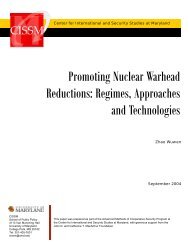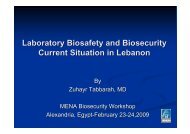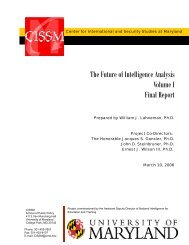A Reassurance-Based Approach to Space Security - Center for ...
A Reassurance-Based Approach to Space Security - Center for ...
A Reassurance-Based Approach to Space Security - Center for ...
- No tags were found...
Create successful ePaper yourself
Turn your PDF publications into a flip-book with our unique Google optimized e-Paper software.
or debris-generating activities) while allowing some <strong>for</strong>ms of temporary, reversible, andlocalized interference (e.g., electro-optical sensor dazzling or radio-frequency jamming) whenit would be consistent with U.N. Charter rules <strong>for</strong> the use of <strong>for</strong>ce and other internationallaw. Meanwhile, the U.N. Committee on the Peaceful Uses of <strong>Space</strong> (COPUOS) would doparallel work on best practices and coordinating mechanisms so that the number anddiversity of space activities could continue <strong>to</strong> increase without a corresponding rise ininadvertent dangers (e.g., space traffic accidents or safety hazards posed by satellites falling<strong>to</strong> earth). Implicit in the Canadian paper is the need <strong>to</strong> develop refined rules <strong>to</strong> determinewhen activities that do not damage or destroy satellites constitute irresponsible behavior orimproper interference with the right <strong>to</strong> use space <strong>for</strong> peaceful purposes, and when theywould be legitimate <strong>for</strong> self-defense or other compelling reasons.As the Canadian paper notes, the OST was the best space security agreement thatcould have been negotiated in the 1960s, given the adversarial nature of the superpowerrelationship, the early stage of space technology, and the embryonic state of arms control. 16The OST established that all states were free <strong>to</strong> use space “on a basis of equality…inaccordance with international law…and in the interests of maintaining international peaceand security.” It <strong>for</strong>eclosed a few undesirable avenues <strong>for</strong> competition (orbiting weapons ofmass destruction and conducting military activities on celestial bodies) and tacitly legitimatedsatellite reconnaissance. It also urged states <strong>to</strong> consider other space users’ interests and <strong>to</strong>consult about any activities that might cause harmful interference. The central idea behindthe OST—that the best way <strong>to</strong> protect vulnerable satellites was <strong>to</strong> connect rights <strong>to</strong>responsibilities and restraints on terms that applied equally <strong>to</strong> all space-faring countries—remains as valid <strong>to</strong>day as when the treaty was negotiated.Much has changed, though, since the early years of the space age when the principlesand policy declarations that <strong>for</strong>med a basis <strong>for</strong> the OST were developed. 17 The Canadianpaper focuses on the technological advances that could lead <strong>to</strong> more widespread ASATcapabilities, particularly the growing number of countries that have, or could soon develop,ballistic missiles, hit-<strong>to</strong>-kill missile defense intercep<strong>to</strong>rs, and small maneuverable satellites.Depending on their level of technological sophistication, numerous countries and even somenon-state ac<strong>to</strong>rs have many ways they could—in theory at least—interfere with the normalfunctioning of satellites. 1816 Treaty on Principles Governing the Activities of States in the Exploration and Use of Outer <strong>Space</strong>, includingthe Moon and other Celestial Bodies, 601 U.N.T.S. 206 (1967).17 The United States made a concerted ef<strong>for</strong>t <strong>to</strong> establish the peaceful nature of its space program and thelegitimacy of reconnaissance satellites, including a series of choices that led <strong>to</strong> the Soviet Union becoming thefirst country <strong>to</strong> launch a satellite. The two broadest security principles in the OST – that international lawapplies <strong>to</strong> outer space and that outer space is free <strong>for</strong> all states <strong>to</strong> use in con<strong>for</strong>mity with international law –were first adopted by the UNGA in 1961, then elaborated by COPUOS in<strong>to</strong> the declaration of legal principlesadopted by the UNGA in December 1963. One of the OST’s two specific prohibitions on military uses ofspace, its ban on weapons of mass destruction in orbit or on celestial bodies, began as parallel unilateraldeclarations of restraint made by the superpowers and endorsed by the UNGA in Oc<strong>to</strong>ber 1963.18 Options <strong>for</strong> interfering with satellites are evaluated in much more detail in David Wright, Laura Grego, andLisbeth Gronlund, The Physics of <strong>Space</strong> <strong>Security</strong>, American Academy of Arts and Sciences Occasional Paper (2005),pp. 125-128, at http://www.amacad.org/publications/Physics_of_<strong>Space</strong>_<strong>Security</strong>.pdf.14







